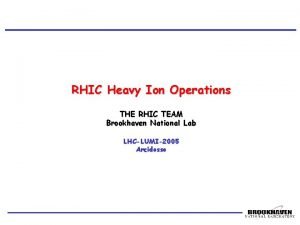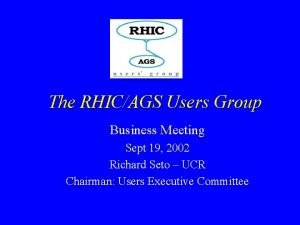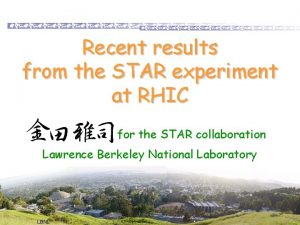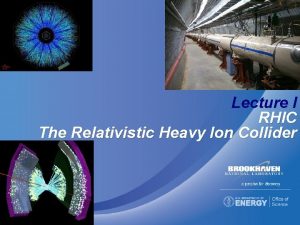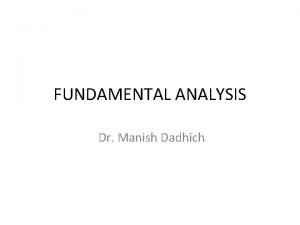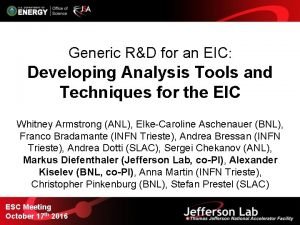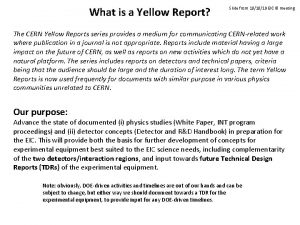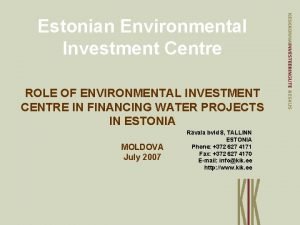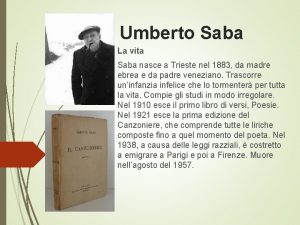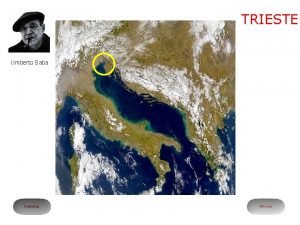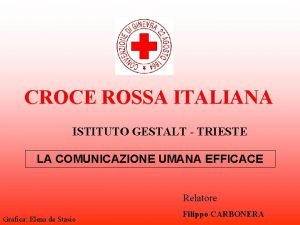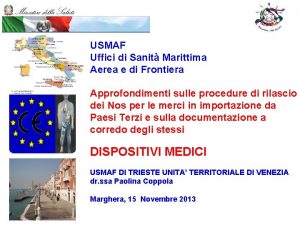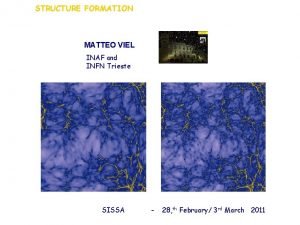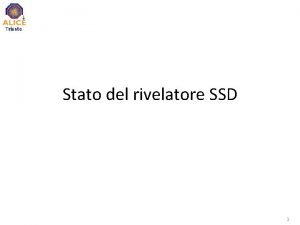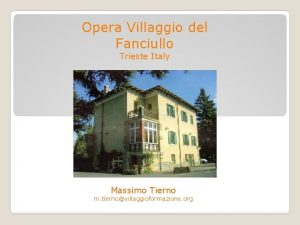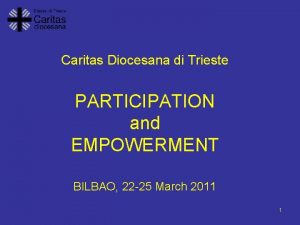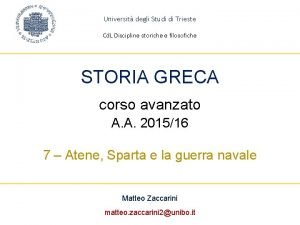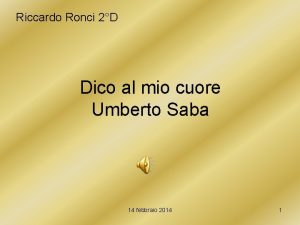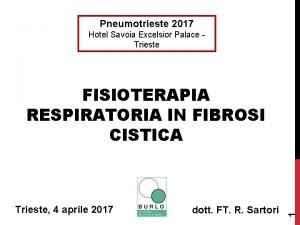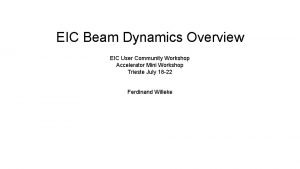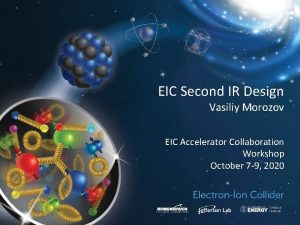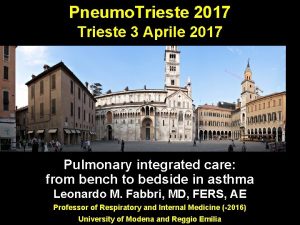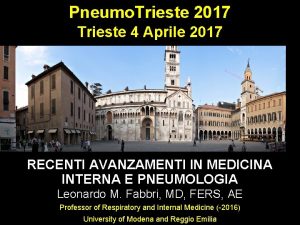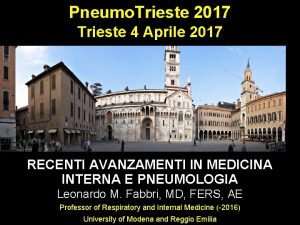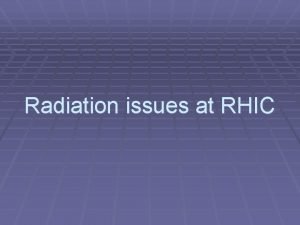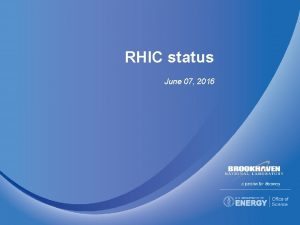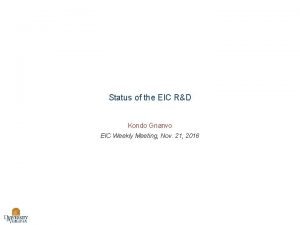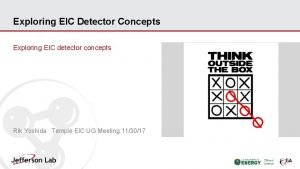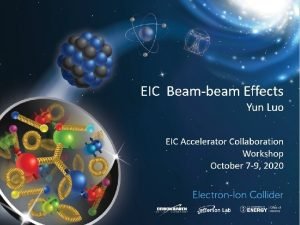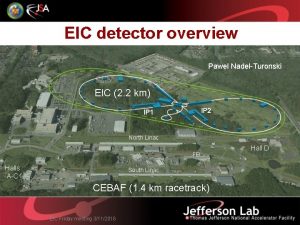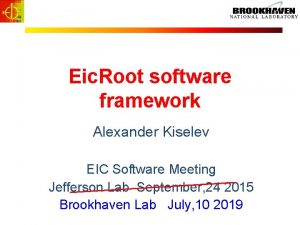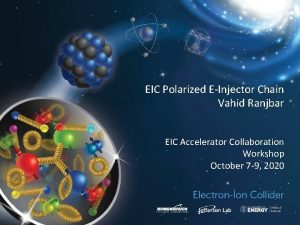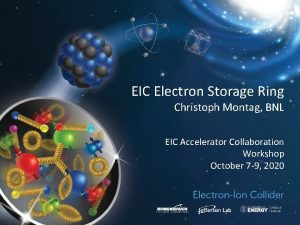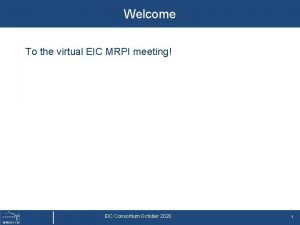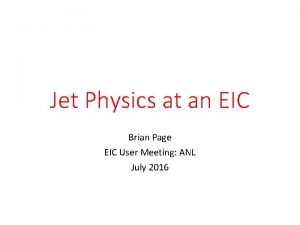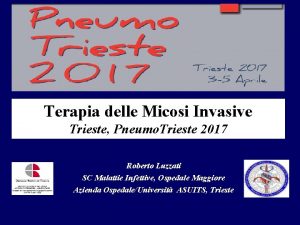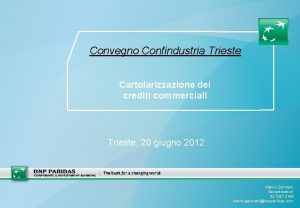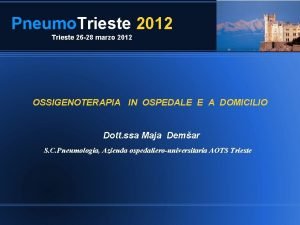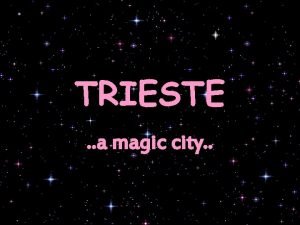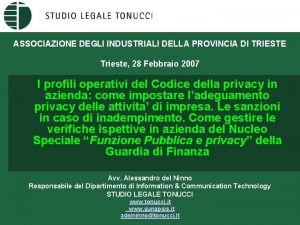e RHIC Design EIC User Workshop 2017 Trieste




























- Slides: 28

e. RHIC Design EIC User Workshop 2017 Trieste, July 18 -22, 2017 Ferdinand Willeke BNL

Outline • e. RHIC Requirements • e. RHIC Concept • Accelerator Layout • Accelerator Design and R&D • • IR Design • Storage Ring Lattice • Beam-Dynamics Issues • Cooling Polarization • • Injectors Timeline 2

Questions to be answered by an EIC How is the proton and neutron spin of ½ composed by its constituents? We don’t know how the proton spin is composed. We know that the most simple assumption of quark spin configuration was proven wrong in 1987. Since then, despite many efforts, this remains an unresolved question. The EIC with its two colliding polarized beams be shed light on this mystery. • How are the gluons spatially distributed in the nucleons? There are hints that the high stability of the proton is due to the fact that the gluons are concentrated near the surface of the nucleon. An EIC will enable us to measure this. • • How does the gluon density saturate? Earlier lepton hadron scattering experiments showed that the density of the gluons increases dramatically if they carry smaller fraction of the nucleon’s momentum. First principles tell us this density increase must saturate, but we do not know when and how. Is saturation related to other unexplained phenomena? Electron-Ion collisions at high collision energies will make a significant step forward to understanding. • The EIC will enable novel measurement of nuclear structure and dynamics which will enhance our understanding of the “nucleon’s inner landscape”. 3

EIC Requirements 4

e. RHIC Design Concept

e. RHIC uses the Relativistic Heavy Ion Collider RHIC • • • The major part of a future e. RHIC facility already exists e. RHIC uses the Yellow Ring and parts of the Blue Ring Most of RHIC will remain untouched RHIC beam parameters will satisfy e. RHIC requirements Some changes in the straight sections are required to maintain a constant revolution time independent of energy 6

e. RHIC Schematics 7

Main Parameters for Maximum Luminosity Ep = 275 Ge. V, Ee= 10 Ge. V 8

Luminosity vs. Center of Mass Energy Ecm 9

High Beam Current Electrons Total Beam Current: up to 2. 7 A • Not unprecedented (KEK-B, Super-B), but Nb=330, beam heating more challenging • Synchrotron radiation limited to 10 MW • RF cost: 30 single cell s. c. 560 MHz cavities • Peak linear power density<6 k. W/m ok with Cu beam pipe • Coupled Bunch instability: need active damper • Resistive Wall Instability ok • Fast Ion instability growth time manageable High Bunch Frequency: fast kickers with <10 ns rise times for injection of electrons and hadrons Protons Total Beam Current up to 920 m. A (factor 2 above present RHIC) • Coupled Bunch Instability, ok • e-Cloud: Need Cu coating of RHIC beam pipe + carbon layer for SEY suppression: prototype coater tested 10

RF Cavity Options • Staged RF installation: 1 st 10 Ge. V Operations with optimized coupling for High Intensity Operations, then RF installation for 18 Ge. V but only 200 m. A of current • Option 1: KEK-B cavity has been operated successfully under comparable conditions, semi-commercial need 15 -34 units for 10 -18 Ge. V, Assuming U = 2 MV and P= 400 k. W $$ • Option 2: CESR-B Cavity is successfully operated in several light sources, for example NSLS 2, commercially available. Would need 15 -34 units for 10 -18 Ge. V, Assuming U = 2 MV and P= 400 k. W $$ Would have to use coaxial coupler (design completed) and fix the Indium-seal, the weak point of the design • Option 3: In-house development of a 3 -cell cavity in progress to save cost. Impedance 12 2 -cell units, Work in progress 11 All solutions: Broad and narrow band impedance manageable; TMCI ok, Coupled bunch Growth rates < 1 k. Hz

Considerable electron single bunch currents Ib = up to 3. 8 m. A • Ie x Ieb = 0. 0046 amp 2 factor ~10 larger than confirmed by B-Factory experience • Avoid heating of vacuum components (bellows) needs careful low impedance design (in progress) Single bunch instabilities: - TMCI ok for typical impedance < 1 MW, - microwave instability ok • 12

Small emittance @ required bunch current and length L = 1. 2∙ 1034 cm-2 s-1 requires vertical normalized proton emittance of ey. N = 2. 2 mm rad @ Ibp= 0. 7 m. A, ss = 7 cm. These Hadron beam parameters are subject to strong IBS and can be achieved and maintained only be strong active cooling of the Hadron beams with cooling times in the order of 30 minutes. Major technical challenge for any EIC design Cooling time < IBS growth time only 0. 5 h • This exceeds the cooling rates possible with stochastic cooling by several orders of Fastest IBS growth for High magnitude Acceptance Optics with L~ 1034 • Coherent Electron Cooling promises to tibs > 0. 3 h (might be able to avoid) provide required cooling rates • Novel scheme, never implemented e. RHIC Choice is to go with Ce. C but • Proof of principle tests in progress will consider alternative schemes Need novel cooling schemes to meet as well this challenge 13

Coherent Electron Cooling Principle E < Eh V. N. Litvinenko, Y. S Derbenev, Physical Review Letters 102, 114801 (2009). Eh E < Eh Hadrons Modulator Dispersion section ( for hadrons) Eh E > Eh Kicker High gain FEL (for electrons) Electrons cooling of high energy Hadron beams with high band-width; BW: 1 THz cooling times of sec-min to balance strong IBS 14 14

Proof of Principle Experiment Installed in RHIC IR-2 Beam direction Status: • all hardware components in place, • improvements after first commissioning in 2016 implemented, • recommissioning in progress • Cooling studies planned for FY 18 15

Critical Beam-Beam Parameters Electrons Simulation: Coherent bb Instability Threshold Red: Np=1011 stable Blue: Np=3∙ 1011 unstable e-Centroid p-Centroid The beam-beam parameters for e. RHIC are ambitiously high • e b-b parameters have been achieved in e+ecolliders (B-Factories) • Choice of e. RHIC e Tunes take into account Polarization • Hadron B-B parameters routinely achieved in RHIC • However, HERA operated with lower values, especially in the horizontal plane xx=0. 03, xy=0. 05 • Occasionally Coherent BB instabilities were observed in HERA • Additional concern Hadron emittance growth (none observed in HERA) • Hadron beam tails and large detector backgrounds Concern addressed in comprehensive b-b simulation study (strong-strong; weak strong) Results so far: Threshold for coherent instabilities 16 factor 2 above operating point, for optimized tunes no or little proton emittance growth

Beam-Beam Parameters Electrons Additional Concern: Strong electron Beam-Beam effects require strong radiation damping. Between 5 -18 Ge. V, tx changes by a factor 50 (without further measures). With” super-bend” lattice: • achieve 11 Ge. V damping times at 5 Ge. V to match KEKB damping decrement • overcomes as well the E 2 scaling of beam emittance, • helps with polarization Radiation Power: ~E 2 B 2 cartoon 17

Small beta, IR design 18

Layout of the Interaction Region Highly constraint problem: • • • • Focus both beams to small size large luminosity Separate the beams quickly to allow for magnets close to the focal point, Crossing Angle Geometry 22 mrad Crab cavities to be accommodated in the IR for both beams Avoid excessive Chromaticity generated in the IR Shield Electrons from strong focusing and deflection magnets for hadrons Provide large acceptance for small angle scattered hadrons (close to beam detectors or Roman Pots) is in conflict with small beam size which implies large beam divergence Large acceptance for entire detector No accelerator components near the interaction point (+/-4. 5 m) Avoid generation of synchrotron radiation which destroys sensitive detectors and can produce significant backgrounds Provide acceptance for luminosity measurement and forward neutron detection Accommodate spin rotators Accommodate near-beam detector components (Spectrometer magnets, roman pots) 19

Interaction Region Layout (note distorted scale) • Interleaved arrangement of electron and hadron quadrupoles • 22 mrad total crossing angle, using crab cavities • Beam size in crab cavity region independent of energy – crab cavity apertures can be rather small, thus allowing for higher frequency • Forward spectrometer (B 0) and Roman Pots (R 1 -R 4) for full acceptance 20

Conceptual Layout of IR Magnets with active shielding magnets with direct-wound coil including cancelling dipole to shield electron Prototype for actively shielded quadrupole Q 1 already exists as part of ILC work Hadron superconducting quadrupole with hoses in the return yoke for electrons Spectrometer magnet in the Hadron line close to detector: detection of forward scattered Hadron Generation of dispersion downstream for increased pt acceptance Conceptual design for 21 super-ferric dipole With actively shielded pipe for electrons

Crossing Angle Geometry and Crab Cavities Prototype of a double quarter wave length s. c. crab cavity (father of the prototype to be installed in SPS for the LHC crab cavity test) Simulation of crabbing and crab cavity effects just started needs more effort Example: Results on the quest of Higher Harmonic Crab Cavities Simulation taking into account • linear BB, • Energy pick up in the cavity • Path length and orbit effects due to dispersion in the crab • Crab dispersion effect • Nonlinear BB with crab: in progress 22

Beam Polarization Requirements • The two beams must be longitudinally spin polarized in collisions • 70% hadron polarization, 80% electron polarization • All combinations of spin orientations present in one fill Hadron Polarization - Polarized protons with P > 60% are already provided by RHIC and its injector chain no design concern at this point - H 3 Polarization: source available soon, requires additional Siberian Snakes taken from the Blue Ring Electron Polarization Sokolov-Ternov either too slow (at 5 -18 Ge. V) or detrimental for spin || B-dipole - Storage ring requires full energy injection of polarized bunches, no top off Drives the requirements of the injector chain from source to high energy accelerator 50 n. C polarized source: SLAC gun: 16 n. C 120 Hz, e. RHIC 50 n. C 1 Hz, may need accumulator superconducting recirculating linac $$ or rapid cycling synchrotron Storage Ring Polarization • Spin || B-dipole: depolarization by Sokolov-Ternov effect, need exchange bunches every 6 minutes (kick-in / kick out) • Spin Polarization preservation will be based on HERA experience: Spin matching, harmonic orbit control, choice of tunes near integer resonance, …. 23

Polarized Electron Source • R&D activity for a polarized source (80%) underway: • Goal 5 n. C bunches spaced by 100 ns 50 m. A • For present e. RHIC design approach need a 50 n. C polarized (80%) electron gun with 1 Hz repletion frequency • SLAC Gun might be a good starting point. It delivered 16 n. C @120 Hz • In conjunction with a small accumulator ring, it will satisfy the demand • • + • However polarized gun designs have been improved since the SLAC gun was developed and operated and these improvement promise • e. RHIC inverted gun with large cathode size promises performance of 50 n. C within surface charge limit. 50 n. C beam transport looks ok 24

Polarized e. Gun R&D: Beyond State of the Art Design Gun Vessel 10 -12 torr 25

Cost Effectve Spin Transparent Electron Accelerator Rapid Cycling Synchrotron with Suppressed Intrinsic Spin Resonances due to high 48 -fold quasi Symmetry Costly Linac can be replaced by much cheaper fast cycling synchrotron If electron polarization can be preserved. Idea: synchrotron with highly symmetric arcs connected by lattice with unity beam transport First simulation results without error compensation and 5 ms ramp time encouraging. Spin Transparent Straight Spin Transparency simulation 26

Spin Transparent Electron Acceleration (Fall Back) Straight forward Choice: • Recirculating s. c. LINAC, 647 MHz, 3 Ge. V, Accelerating gradient: 25 MV/m • Rep Rate 1 Hz, single bunch 50 n. C • • • Five re-circulation loops Need some waveguide HOM damping to avoid accumulation of beam induced fields Challenge to fit in the RHIC tunnel together with 2 RHIC rings and Storage Ring • LINAC beam dynamics has been checked ok Dp/p for SR injection • Energy spread at SR injection manageable • Main Disadvantage of this scheme: • cost, need 120 m of active structure at ~>(1 -1. 5) M $/m • Prototyping of Cu model and Nb cavities and waveguide HOM underway Plus 250 M$ for five return loops. • FFAG based return loops could save some of this cost. • Cbeta test accelerator at Cornell Univiersity (under construction) 27

SUMMARY • The planned construction of an Electron In Collider is supported by the Nuclear physics community and is prominent part of the NP long range plan. • Accelerator based nuclear physics experiments and studies in the field have led to a strong and exciting physics case of the EIC which is acknowledged not only in the Nuclear Physics community but also stirred the interest in the High Energy Physics Community in particular in the Deep Inelastic Scattering Community, as fundamentally new physics could emerge from an EIC physics Program. • The BNL version of the EIC makes use of the existing RHIC accelerator complex, which constitutes more than 2/3 of the cost of such a facility is called e. RHIC. The e. RHIC design has evolved recently - from an ERL based solution which is quite cost effective but has unresolved technical risks - to a concept based on an Electron Storage Ring with peak luminosity in excess of 1034 cm-2 s-1 and cm energy ranging between 30 Ge. V and 140 Ge. V • • The accelerator design uses only accelerator components and electron and Hadron beam parameters which have already been demonstrated, • While luminosities of a few times 1033 cm-2 s-1 are considered reasonably likely, reaching luminosities of 1034 cm-2 s-1 and beyond need strong hadron cooling, still to 28 be demonstrated • There is a significant cost saving opportunity by using equipment from retired
 Rhic brookhaven
Rhic brookhaven Rhic ags users meeting 2020
Rhic ags users meeting 2020 Rhic
Rhic Orbital revolution
Orbital revolution Eic approach of fundamental analysis
Eic approach of fundamental analysis Fiu password reset
Fiu password reset Qa eic patel
Qa eic patel Eic software software review
Eic software software review Kickoff meting
Kickoff meting Yellow report eic
Yellow report eic Www.eicindia.gov.in health certificate
Www.eicindia.gov.in health certificate Eic european investment centre
Eic european investment centre Infor cloud suite
Infor cloud suite User interface design in system analysis and design
User interface design in system analysis and design Input design
Input design Single user and multi user operating system
Single user and multi user operating system Types of operating systems
Types of operating systems Saba goal zanichelli
Saba goal zanichelli Umberto saba trieste analisi
Umberto saba trieste analisi Istituto gestalt trieste
Istituto gestalt trieste Usmaf trieste
Usmaf trieste Synchronic
Synchronic Ssd trieste
Ssd trieste Villaggio del fanciullo trieste
Villaggio del fanciullo trieste Caritas bilbao
Caritas bilbao Lenormant
Lenormant Dico al mio cuore intanto che t'aspetto figure retoriche
Dico al mio cuore intanto che t'aspetto figure retoriche Stelle sulla terra trama
Stelle sulla terra trama Drenaggio posturale
Drenaggio posturale
